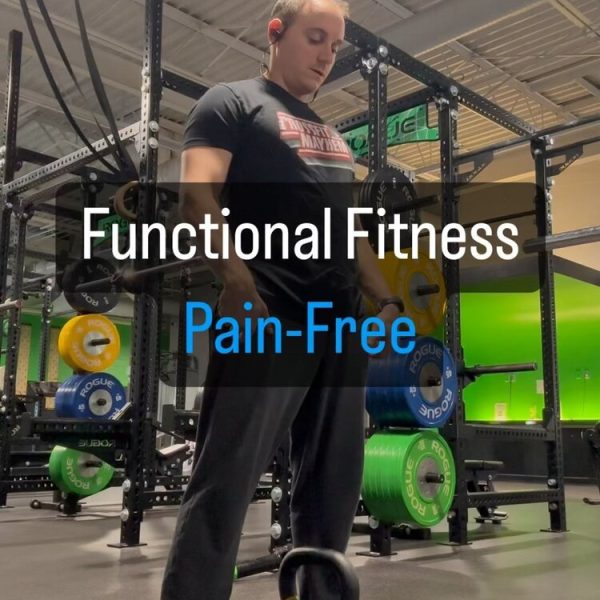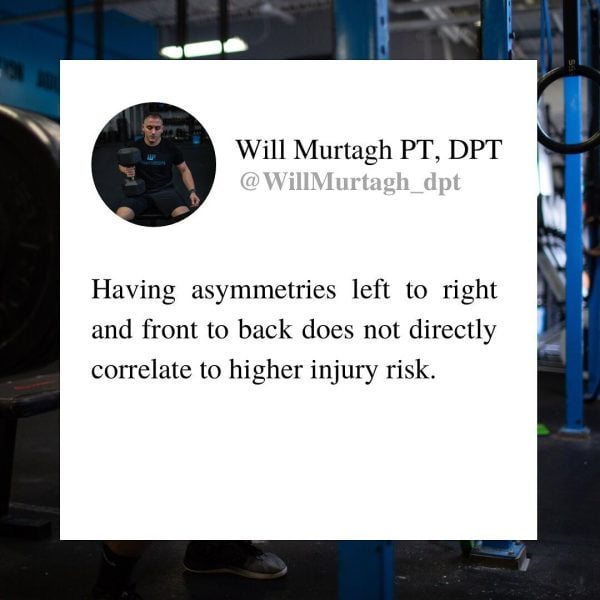Dr. Will Murtagh is a performance physical therapist and writer who helps Fitness Athletes elevate their fitness and train pain-free.
Over the past 12 years working with CrossFitters and Division One athletes, I have yet to see a movement that challenges strength, balance, and joint mobility like the ATG split squat does. It is a great training tool for optimizing their fitness and performance. I routinely prescribe it to my clients inside my 1:1 Pain-Free Performance Program.
This article will discuss how to properly execute the ATG split squat, the benefits and drawbacks of the exercise, and common progressions and regressions so that you can master the movement and reap all of its benefits. Let’s dive in!
How To Perform The ATG Split Squat
How To Perform the ATG Split Squat
- Start in a standing position with your feet hip-width apart.
- Take a large step forward with one leg, landing with your front foot flat on the ground.
- The front heel should be directly under your knee, and the toes can be slightly pointed outward for better stability.
- Lower your body down and forward by flexing at both knees but pushing the front knee beyond your toe with the trailing leg remaining relatively extended.
- Crucially, in the ATG split squat, you aim to achieve a full depth where your back knee touches the ground, and your front leg hamstring rests on your calf.
- Maintain an upright torso throughout the movement. Your core should be engaged to keep your spine neutral.
- Push through your front heel and extend both knees to return to the starting position.
- Complete the desired repetitions on one leg before switching to the other.
Watch a demo video (HERE)
Progressions To The ATG Split Squat
Dumbbell ATG Split Squat
How it’s harder
Holding dumbbells during the ATG split squat increases the total load that must be overcome by the front leg. Holding one or two dumbbells also increases instability since the dumbbells are freely hanging and must be controlled by the core muscles. This is especially true if you are only holding one dumbbell.
Watch a demo video (HERE)
Front Rack ATG Split Squat
How it’s harder
Placing a barbell across the shoulders to perform the ATG split squat makes it more challenging in a few ways. First, you will be able to further increase the loads you can use with a barbell over a dumbbell. Second, adding a barbell to the front rack position raises the center of mass and, therefore, adds another level of stability demand for the core muscles and lateral hip stabilizers.
Lastly, the front rack position is very taxing on the anterior core muscles, and as you descend into the lunge, the core must work overtime to maintain an upright posture laterally and now also maintain posture front to back.
Watch a demo video (HERE)
Back Rack ATG Split Squat
How it’s harder
The back rack ATG split squat places even more demand on the movement as you can now use the most weight possible to maximally challenge the front leg.
However, it also raises the stability demand to another level as the load is transferred to the back of the shoulders, which is thus raised a touch higher by the upper traps. This variation also adds another layer of shoulder mobility to achieve a back rack position in a lunge.
Watch a demo video (HERE)
Overhead ATG Split Squat
How it’s harder
The overhead ATG split squat is the highest level of the ATG split squat that you can perform due to the significant range of motion and stability requirements.
You will likely be unable to use as much weight as the back rack variation. Still, the height that the barbell reaches with extended arms raises the center of mass tremendously, which maximizes the instability component.
It also requires an extensive range of motion in the shoulders, thoracic spine, and shoulder blades in addition to the already high mobility demands of the lower body.
Watch a demo video (HERE)
Regressions To The ATG Split Squat
Elevated ATG Split Squat
How it’s easier
The elevated ATG split squat reduces the amount of joint mobility required by the ankle, knee, and hip. This way, you can gently ease into any restrictions that you may have and gradually decrease the eight of the box or step as you improve your range of motion.
Watch a demo video (HERE)
Assisted ATG Split Squat
How it’s easier
The assisted ATG split squat removes or decreases the movement’s balance and stability requirements. The more points of contact you have with the ground, the more stable you will be. Conversely, as you remove contact with the ground, the less stable you will be and the more your ankle, hips, and core muscles will have to work to maintain an upright posture.
Watch a demo video (HERE)
Main Benefits of The ATG Split Squat
Increased Strength & Stability
The ATG split squat is an excellent option for developing lower body strength and stability, particularly unilateral or “one-sided” strength and stability since it is a single-limb exercise. (1)
Unilateral exercises come with different strengths, stability, and work capacity demands because not only do they require control of the body through a range of motion, but they are also done without the help of the other limb. Effectively placing twice the demand on the working limb from a total load and anti-rotation standpoint. (1)
The ATG split squat is a lunge variation, particularly beneficial for activating the glute max muscle. Research has shown that single-leg lunge variations like the split squat and all step-up variations have higher muscle activation of the gluteus maximus over other common lower-body exercises such as the deadlift or hip thrust. (2) Thus making it a powerful strength and general hypertrophy enhancer for the legs.
Increased Lower Body Mobility
To move effectively through the ATG split squat motion, a large amount of ankle, knee, and hip mobility is required. If you don’t have the full range of motion in these joints, working on various regressions of the exercise or with reduced loading of the traditional movement can help to expand each joint’s motion over time.
At the bottom position of the ATG split squat, you will notice that the ankle is in almost maximal ankle dorsiflexion, knee flexion, hip flexion of the front leg, and maximal hip extension of the back leg. With each repetition, these joints are loaded via your body weight and, with appropriate progression in load over time, will begin to expand joint capsules, and muscles around the area become more robust and more flexible.
Increased Hip Muscle Flexibility
Another benefit of ATG split squat training is the increase in flexibility of the hip flexors. Since most humans sit for the majority of the day, the hip flexors can become tight due to chronic positioning over time. This can lead to a host of issues, such as an altered ability to achieve a deep squat, knee pain, and lower back pain.
But by training the ATG split squat, you can increase the flexibility of the hip flexor of the trailing leg as you push forward in the movement. As the back leg trails behind you, the hip flexor is lengthened, and over time, it will decrease its resistance to stretch and reduce its impact on your lower back and knee. You will also experience increased hip stability due to a strengthening of the hip flexor from progressive loading over a large range of motion.
Knee Health and Injury Prevention
Contrary to popular belief, deep range-of-motion squatting is not harmful to your knees, and building knee strength at end ranges of motion is a great way to decrease your risk of injury. As long as proper form is maintained, loading the knee stabilizers in deep knee flexion will build resiliency in the knee, effectively allowing you to both rehab current knee issues and mitigate training-related knee injuries over time.
The knee is one of the body’s synovial joints, and as the knee of the weight-bearing leg moves through a full range of motion, more synovial fluid is produced. Providing much-needed nutrients for the knee joint to maintain cartilage and remove waste products.
Drawbacks of The ATG Split Squat
Range of Motion Requirements
Although the deep range of motion required for the ATG split squat can be a great benefit, it also poses a challenge for those who need an adequate range of motion in the joints or muscle groups involved. One of the common mistakes made when using the ATG split squat in training is forcing it into your workouts when you aren’t ready for it.
Some limitations in joint mobility are fine to train through, as you may just need strengthening to expand the joint’s mobility. But if you severely lack the range of motion in the ankles, knees, and hips to the point where you cannot achieve the required joint angles or the exercise causes pain, then it would be best to choose one of the regressions I mentioned above as a starting point.
Once the joints of your lower body move with an increased range of motion using various isolated mobility drills, you can progress toward the full ATG split squat.
Balance Component
Since the ATG split squat is a single-leg movement, a high level of balance is required to perform it. (1) As you descend and forward, the core muscles and the lateral hip stabilizers, such as the gluteus medius, have to be strong enough to maintain your upper body position and prevent compensation at the hips. (1)
If these muscles aren’t strong enough to do so, then the ATG split squat will likely be too challenging of a movement for you. In this case, you would benefit from adding additional layers of stability, such as holding on to a squat rack or using a PVC pipe in the opposite arm for a counterbalance.
If these additional layers of stability aren’t added, you will likely compensate in some fashion, and the benefits of the exercise will be diminished.
Using The ATG Split Squat In Your Training
Warm Up & Activation
The ATG split squat is a great way to prepare the ankle, knee, and hip joints for lower-body strength training. I particularly like using the movement to prepare for any squat exercise. The ATG split squat will have more range of motion demands than all squat variations.
If my lower body joints move well enough for the ATG split squat, they will be ready to perform bilateral or double-leg squats.
Primary Strength Lift
The lunge movement is one of the six foundational movement patterns in addition to squat, hinge, push, pull, and core. Thus, the ATG split squat as a primary strength lift is a great way to develop the lunge pattern.
Unilateral strength training can also mitigate the bilateral deficit, a phenomenon where the total strength of each limb added together does not equal how much weight can be handled by the two legs working together. (3)
There are proposed reasons for this, such as nervous system coordination and inter-hemispheric interference. (2) Regardless of the reason it occurs, strength training on one leg can allow you to overload the muscles of each limb to a higher degree than you would be able to if you were training them in a bilateral exercise because you can use a larger relative load per leg.
Theoretically, this leads to significant strength improvements over time.
Accessory Exercise
Lastly, the ATG split squat can be used as an accessory exercise to other lower-body strength lifts, such as Olympic lifts, back squats, or deadlifts.
The muscle activation of the glutes and quadriceps during the movement makes the ATG split squat helpful in increasing the strength of these muscle groups.
This translates to improved performance on the platform during CrossFit, Powerlifting, or Olympic weightlifting competitions.
Alternatives To The ATG Split Squat
Bulgarian Split Squats
How it’s different
The Bulgarian split squat differs from the ATG split squat in that there is no forward translation of the working knee, as it will typically remain stacked over the ankle joint as the hip moves into flexion. The lifter will also place their non-working leg on a bench or box behind them to help isolate the working leg in front.
Watch a demo video (HERE)
Split Squats
How it’s different
Split squats are different from ATG split squats in that there is more flexion in the trailing leg. Hence, the bottom position resembles an actual lunge position. In this position, the trailing hip flexor is shorter, so it is not challenged to the same degree. There is also less hip flexion, so there likely is less glute activation in a traditional split squat than in an ATG split squat.
Watch a demo video (HERE)
Walking Lunges
How it’s different
Walking lunges possess the same differences to the ATG split squat that split squats do, but with an additional difference in that, as the name implies, you are translating forward by stepping into each repetition. Thus, it is not static but dynamic and is better suited for athletes who have to move under load, such as a CrossFit or Strongman athlete.
Watch a demo video (HERE)
Final Thoughts on The ATG Split Squat
The ATG split squat can be a powerful tool in your arsenal of gym exercises to develop the strength, muscle mass, and endurance of your lower body. It challenges the body in many ways, from joint mobility and flexibility to strength and balance, making it one of the best bang-for-your-buck exercises in fitness today.
Consider incorporating the ATG split squat into your training program to reap these benefits. Whether you’re a CrossFit athlete or a general fitness enthusiast, you will benefit from this exercise. Start by critically evaluating where you sit in your ability to perform the lunge and pick one of the variations I mentioned above as a starting point. Then progress in difficulty as your fitness level improves and avoid forcing a range of motion, especially under heavy load.
If you have questions or would like to elevate your fitness level and train without joint pain, I invite you to book a free consultation HERE to see how my 1:1 Pain-Free Performance program can help. I look forward to learning more about you and your goals!
References:
1. Behm, D. G., Colado, J. C., & Colado, J. C. (2013). Instability resistance training across the exercise continuum. Sports health, 5(6), 500–503. https://doi.org/10.1177/1941738113477815
2. Neto, W. K., Soares, E. G., Vieira, T. L., Aguiar, R., Chola, T. A., Sampaio, V. L., & Gama, E. F. (2020). Gluteus Maximus Activation during Common Strength and Hypertrophy Exercises: A Systematic Review. Journal of sports science & medicine, 19(1), 195–203. https://www.ncbi.nlm.nih.gov/pmc/articles/PMC7039033/
3. Whitcomb, E., Ortiz, O., Toner, J., & Kuruganti, U. (2021). The bilateral limb deficit (BLD) phenomenon during leg press: a preliminary investigation into central and peripheral factors. BMC sports science, medicine & rehabilitation, 13(1), 89. https://doi.org/10.1186/s13102-021-00321-0













